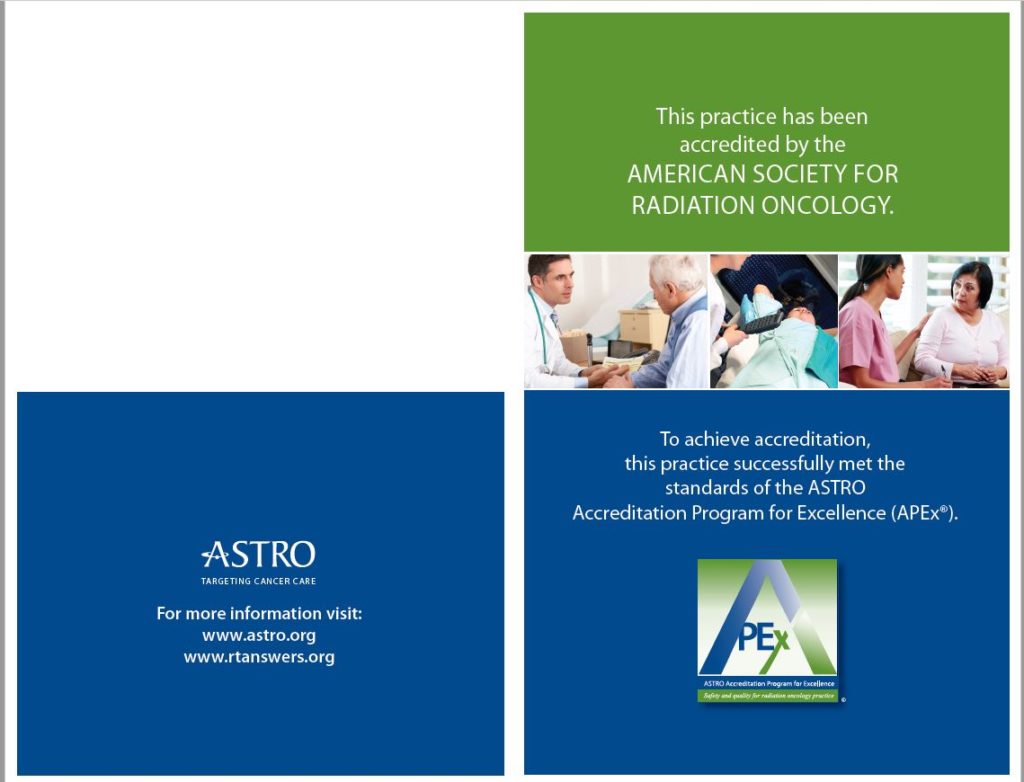How Does Radiation Therapy Work?
Radiation therapy works by causing DNA damage in cancer cells that cannot be repaired and leads to cancer cell death. It can be given externally or internally, depending on the type and location of the tumor. External radiation is delivered by a machine called a linear accelerator that generates high-energy beams that are precisely directed into the tumor. External beam radiotherapy is delivered over several days or many weeks depending on a variety of factors. Internal radiation therapy, also known as brachytherapy, uses radioactive sources that can be temporarily inserted or permanently implanted in the operating room. Radiation from the implant travels only a short distance, which spares most tissues from treatment side effects.
Advanced Treatment Options
Intensity Modulated Radiotherapy (IMRT)
IMRT is a noninvasive therapy that begins by acquiring a Computed Tomography (CT) scan exactly in the treatment position and then fusing other imaging studies like PET and MRI. The physician uses all of this information to precisely define the tumor as well as tissues to be avoided. Physicists/dosimetrists then use a sophisticated treatment planning system to maximize target coverage and minimize normal tissues exposure. The high speed computer does this by “trying” millions of beam segments and intensities until the best solution is determined. The result of IMRT planning is a dose that “shrink wraps” around the target. Although not beneficial for all patients, IMRT for some patients will both improve tumor control and reduce side effects. IMRT is routinely used to treat prostate, brain, and esophageal cancers, among others. A treatment course of IMRT typically spans 5-7 weeks.
Image-Guided Radiation Therapy (IGRT)
IGRT uses a combination of scanning technologies with the control of IMRT that delivers precise amounts of radiation. Continual scans ensure that cancer cells are being treated, while simultaneously avoiding normal structures and organs. IGRT can enable higher doses of radiation to be delivered more accurately and safely, which can increase the chance for tumor control and cure. This radiation oncology option is used to treat tumors close to organs or prone to body movements such as the lungs, liver, and prostate.
High Dose Rate (HDR) Brachytherapy
High Dose Rate (HDR) Brachytherapy is a direct delivery of precise radiation through the use of catheters, or applicators inserted into tissue or a body cavity. HDR briefly places a high activity radioactive source in contact with cancer tissues and is then removed when a curative dose has been delivered to the cancer. This comprehensive, aggressive approach to treatment ensures the maximum radiation dose is given where needed, while sparing the healthy surrounding tissue. HDR is frequently used in breast, cervical, and uterine cancers and has become an effective treatment for early stage prostate cancer. Treatments are typically given in 1-4 weekly doses, with each HDR treatment typically lasting for 3-5 minutes.
Radiation Therapies are targeted treatment options Radiation Oncology is the branch of cancer treatment that uses advanced radiotherapy delivery methods to target and treat a wide range of malignancies. At Virginia Cancer Specialists (VCS), our physicians use advanced treatment planning systems and state-of-the- art radiation technology to deliver treatment that is safer, faster, and more precise than ever before. Our highly trained staff works diligently to make your total experience as convenient and comfortable as possible.
Why choosing an APEx-accredited radiation oncology facility is important for patients.
The ASTRO Accreditation Program for Excellence (APEx) is an independent radiation oncology practice accreditation program. The program is based on a comprehensive set of sixteen standards of radiation oncology practice, organized around five pillars of patient care:
- The process of care
- The radiation oncology team
- Safety
- Quality management
- Patient-centered care
When you choose an APEx-accredited facility, you know that:
- Your facility has voluntarily gone through a rigorous review process by trained radiation oncology professionals.
- Your facility’s policies and procedures have been evaluated using objective, verifiable expectations for performance in radiation
oncology. - Your facility is committed to the highest standards of safety and quality in the practice of radiation oncology.
- Your facility practices patient-centered care by promoting effective communication, coordination of treatment and engaging patients and their families as partners in care.

We are APEX Accredited





